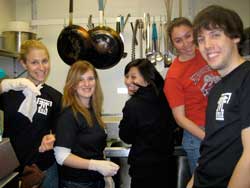Medical students tackle a domestic disaster
|
More than 100 medical students put down their stethoscopes and picked up paintbrushes on March 13 to help residents of Kailo Haven, a shelter for men, with several beautification projects. Kailo Haven is one of two homeless shelters that members of the Temple Emergency Action Corps (TEAC) are working with to help improve access to care for the city’s homeless population. First-year medical students Alison Marshall and Golnar Lashgari, along with second-year student Jennie Johnson coordinated the project as part of TEAC’s domestic disaster response component. TEAC was originally started as a response to Hurricane Katrina, but its scope has expanded to include international efforts (including an upcoming trip to Haiti). But with this project, the group has shifted part of its focus back to local issues. “Fortunately, since we have not experienced a domestic disaster on the scale of Katrina, we have had some time to think about other areas where we could be of help,” said Marshall. “We felt that the homeless situation in Philadelphia is a disaster, because many have very little access to health care and preventive treatments. They wait until they need acute care and have to go to the emergency room.” As the first part of their plan, TEAC has partnered with Project HOME and Resources for Human Development (RHD) to begin offering health and wellness workshops at two local shelters. On Tuesdays and Wednesdays, students go to 1515 Fairmount Ave (a women’s respite shelter) and Kailo Haven to offer information and answer questions on a wide range of health topics, from nutrition to sexual health to managing the cold. “The information that we’re gathering from these sessions really helps us determine what the most prevalent health issues in these communities are. It gives us a better sense of what the community needs, and will help us meet those needs more effectively,” said Marshall. Finding out those needs is helping establish the framework for the second phase of the program. Members of TEAC are in talks with key administrators at each of the homeless shelters, along with Project HOME and RHD, to discuss ways to collaborate on clinical care operations for residents at the two shelters. “We are hoping to start offering clinical services to these residents sometime in the spring, whether by collaborating with RHD’s mobile clinic, or shuttling residents to Temple Hospital to take advantage of internal medicine and psychiatry services,” said Marshall. The TEAC homeless project is open to any medical student interested in providing service for the homeless. TEAC members also offer an elective for students interested in training to become first responders to natural and economic disasters. Marshall said there has been an incredible turnout among the medical student body, as evidenced by the hundreds of students who attended the March 13 event. Additionally, the group is in the process of expanding their health workshops to include podiatry and dental students. “Temple University is well situated to provide services to the surrounding community through its professional schools, while also giving students the opportunity to learn from people in the community who need their help and care,” she said. Ultimately, the end goal of this project — its third component — is the construction of a medical home in North Philadelphia for the underserved population. It will incorporate services from Temple’s professional schools in order to provide comprehensive and coordinated access to health care as well as legal and social services. “We’re very excited about the idea of a TEAC medical home and are working with RHD to put the plan into action,” said Marshall. “The workshops that we are doing now are the crux of what’s being planned for the future, because they allow us to build trusting and communicative relationships with the people that our medical home would serve.” Funding for the Temple Emergency Action Corps is provided by a grant from the Greenfield Foundation whose president, William S. Greenfield, MD, is an 1969 alumnus of the School of Medicine. |
